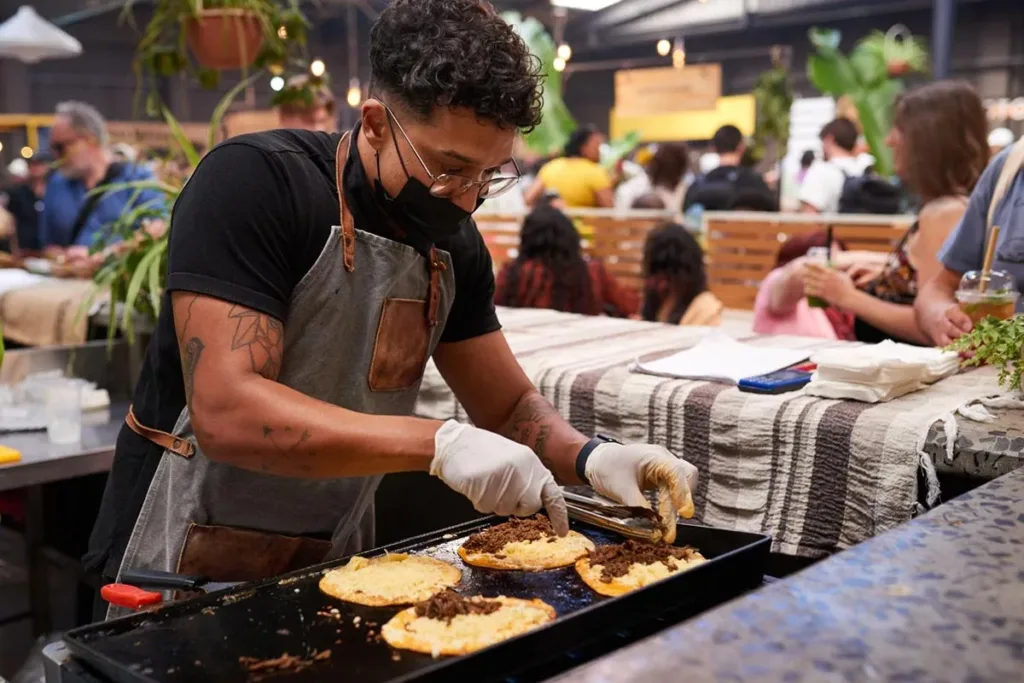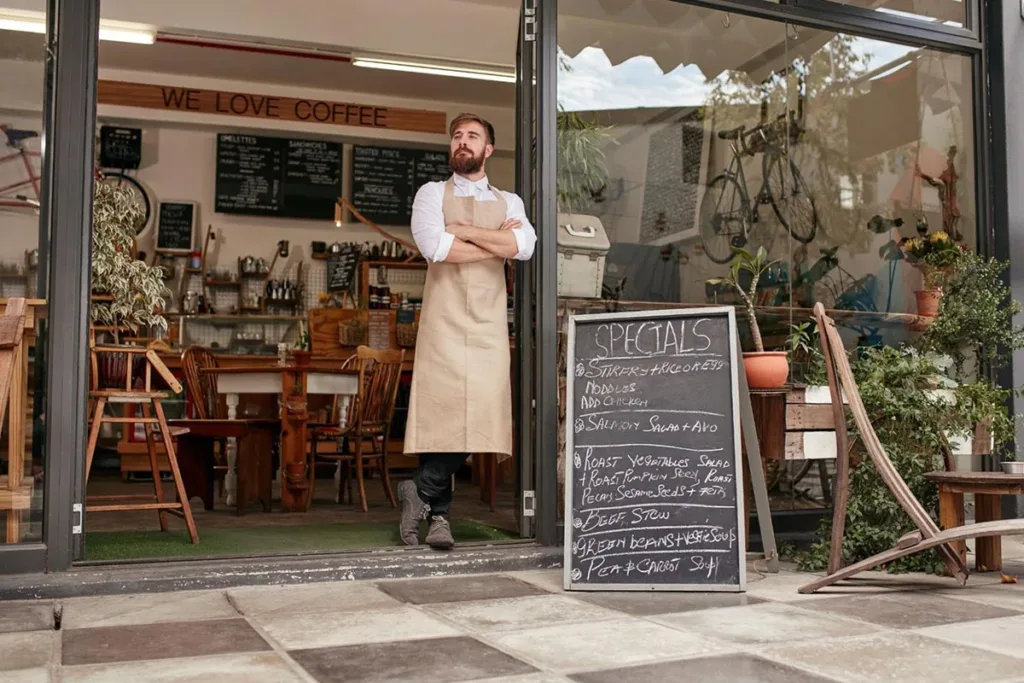6 local restaurant marketing tactics to snag nearby diners
Skip the article and turn takeaways into action by scheduling a call with our team.
Restaurant marketing is a crowded space these days, and restaurants need to be at the top of their game to stay ahead of the competition. With multiple marketing avenues available, one key aspect of marketing remains consistent: The potential customers closest to you are some of the most vital to snag. They’re the ones who’ll actually walk in your door—today or tomorrow, not next month—and who stand the best chance of becoming loyal customers. Luckily, local restaurant marketing strategies have advanced considerably in recent years, and restaurant owners have a lot of options.
Local restaurant marketing—especially hyperlocal marketing, focusing on customers in a tight geographical area—gets the word out to your local community about your business. Making the most of digital profiles, building local partnerships, and developing strong local ties all help build brand awareness. Tech solutions also provide a big boost to local marketing. Let’s take a look at some of the best options available and how they can be used in your marketing campaign.
1. Nail your Yelp profile for max visibility

Yelp is a powerhouse for local marketing. It’s one of the first platforms diners turn to when looking for nearby restaurants. And not just a few of them, either: 76 million consumers visit Yelp each month. Consequently, a well-optimized Yelp profile can significantly increase your chances of showing up in local searches, thus driving foot traffic. To get the most out of your Yelp profile:
- Claim and complete your profile. Make sure your Yelp Business Page is claimed and fully filled out with up-to-date details: your address, phone number, hours, website, and menu. Incomplete profiles can look amateurish and scare off potential customers.
- Use high-quality photos. Beautiful photos of your food and location can make all the difference, especially in our visual-forward society. Diners often make snap decisions based on visuals, so pay attention to plating and presentation in the back-of-house for maximum effect. Share new menu items on your profile immediately.
- Encourage online reviews. Customers absolutely read reviews, which can boost credibility and improve a restaurant’s ranking in the Yelp algorithm. Politely ask customers to leave a review, and take the time to respond to as many reviews as possible. Respond to both negative and positive reviews. Doing so makes you look human and builds your reputation.
- Use Yelp Ads for targeting. Yelp’s advertising options let you target users searching for restaurants in your area. Bid on keywords relevant to your restaurant (e.g., “BBQ near me”) to show up at the top of relevant searches.
- Combine ads with Yelp Guest Manager for a big boost: Guest Manager restaurants that buy Yelp Ads experience up to a 17% monthly lift in diner bookings through Yelp.
- Get the most out of reservations and waitlist usage. Push-button reservations make it easy for customers to be directed to your reservation page. Accurate waitlist times and easy waitlist joining further encourage customers to make an impromptu decision to dine with you.
When used right, Yelp can be a vital ally in the quest for eyeballs on your business and people at your tables. It’s a win for all involved.
2. Get to the top of Google maps and Yelp maps

The Google “map pack” shows the top three local results for a given search query. For example, if you search for “San Diego Vietnamese restaurant” you’ll get the three businesses that rank the best in Google maps’ results. This has huge implications for any restaurant business, since the goal of all search engine optimization (SEO), but particularly local SEO, is to be the top result—which customers click on more. To get to the top and boost your online presence:
- Flesh out your Google business profile. Claim your profile, keep it updated with all vital information and descriptions, and periodically add new photos. Add attributes like “outdoor seating” or “takeout available” to attract specific diners.
- Use local SEO keywords on your profile and your restaurant website. Use hyperlocal keywords in your website and profiles, like your description and location (“Austin pizza”), or get even more local with specific city neighborhoods. Search engines refine for specific locations, and SEO optimization can have a high return on investment (ROI).
- Make sure your name, address, and phone number are consistent. These should be identical across all directories, including on social media platforms.
- Add your full menu, including menu items, photos, and online ordering options, to your profile.
- Collect as many Google reviews as possible. Like with Yelp, reviews build credibility and boost your position in the algorithm.
- Use the strategies in section 1 (“Nail your Yelp profile for max visibility”) to improve your rankings in Yelp maps, which function similarly to Google’s.
Maps will often be one of the first things customers see, and showing up near the top is vital to drawing in foot traffic. Customers will often make a dining decision based on the first business they see that fits their search query.
3. Build partnerships with local businesses

Building up an alliance of nearby businesses can create a self-supporting network of referrals and cross-promotion possibilities. A team goes further than an individual, and businesses that look out for each other can make a big difference in each other’s bottom line. Some ways to build your local restaurant marketing plan with partnerships:
- Run cross-promotions. Build collaborations with local gyms, coffee shops, retail stores, or any other businesses in your area that aren’t direct competitors. Promote their services to your customers, e.g., by offering a discounted gym membership with a purchase from your restaurant, in exchange for similar promotions run by the gym. This helps get the word out about all local businesses.
- Offer to cater. Offer catering services to local businesses for meetings, company parties, or lunches. Include flyers and other promotional materials with the catering,
- Build a local loyalty program. Employees from local businesses can receive a discount for visiting your restaurant with an employee ID or similar (for example, if you recognize them). This can help build your customer base and encourage word-of-mouth advertising.
- Host business events. Suggest your establishment as the go-to site for local company events like team dinners, and offer a special menu or group discounts.
If you build it, they will come. In this case, “it” is a cross-business alliance, and “they” are local customers that can form the foundation of your success. Creating a cross-business marketing plan can have a long-term impact on your position in the community.
4. Go old school: Distribute flyers and promote locally

Traditional marketing still works, despite the apparent dominance of digital marketing tools. Because it’s cheap and fairly straightforward, there’s no reason not to do it.
- Target your flyer distribution carefully. Put flyers in high-traffic areas like nearby apartments, community centers, and college campuses. Include limited-time offers like “10% off this week” for customers who snap a photo of the flyer.
- Work with partners. Like in section 3 (“Build partnerships with local businesses”) above, work with your local business partners to display your flyers at their counters or outside their business, or to include them in bags or check holders. Include special offers like a free appetizer or welcome cocktail.
- Choose a snappy, memorable design. Flyers that look dull are easily ignored, so use images, fonts, colors, or phrases that stand out. Play around with design ideas, and ask your staff to make recommendations.
Flyers are cheap to distribute and can serve as effective passive advertising to net local eyeballs.
5. Make your restaurant part of the community

Cementing yourself as part of your local community can build brand loyalty and attract new customers who might not otherwise have heard of you. Some good community-based marketing efforts include:
- Sponsor local upcoming events. Neighborhood festivals, farmers’ markets, charity runs—these are all viable and wholesome ways to get the word out about your brand and attach yourself to something positive. Whether you show up with a booth or sponsor merchandise with your logo on it is up to you.
- Support a local sports team. The age-old strategy of sponsoring little league teams, adult leagues like softball or kickball, or even a bowling team can build a customer base and get your restaurant brand out there on team jerseys. Offer discounts to your sponsored teams so they know exactly where they’re going after a game.
- Host themed nights. Live music, trivia nights, or outdoor games can all attract customers and turn your establishment into a social hub. Customers will bring their friends, and voila, you’ve gained customer loyalty.
- Create a buzzing happy hour. Office workers who know they can make a beeline to a friendly happy hour with great drinks and snacks often make it a regular part of their week. Operating at a smaller profit margin during happy hour draws customers in during a quiet part of the day.
- Run pop-ups at local hotspots or food festivals. Offer snacks or samples at parks, community centers, or other public spaces to encourage customers to visit your restaurant at a later time.
- Team up with local influencers. Find the most important TikTok foodie influencers in your area with whom you share your target audience. Work out a deal (often paid) for social media marketing partnerships and watch business grow. Notably, 55% of customers visit a restaurant after finding it on TikTok.
There’s often an exponential factor in spreading the word via community-based events. One customer brings in another, and then the whole thing daisy-chains into wide notoriety.
6. Tap into Yelp’s tools

Yelp offers a number of unique tools to hone in on nearby diners, making it a cornerstone of local marketing. Some key local restaurant marketing ideas to consider:
- Leverage Yelp Connect. Use Yelp Connect to post updates about daily specials, new menu items, or events that speak directly to your Yelp audience. A post like “Happy Hour all night tonight!” can attract last-minute diners.
- Use geo-targeted ads. As discussed in section 1, Yelp allows you to target ads to users within a specific radius of your restaurant. This helps catch the attention of hungry customers looking for something nearby.
- Provide check-in incentives. Encourage Yelp users to check in at your restaurant for a free item like a dessert or cocktail. This encourages walk-ins while also boosting your visibility on Yelp.
- Offer last-minute reservation perks. Offer a small discount or free drink for reservations made within a few hours of booking. This can be communicated via Yelp Connect.
- Use unique Booking Links. Yelp Guest Manager customers can create unique Booking Links to share via social media that help customers make a snap decision to make a reservation.
- Track your metrics online. Metrics on your Yelp page like page views, reviews, average rating, clicks, search impressions, and consumer actions all show how effective your online presence is.
- Track your in-house metrics with Yelp Guest Manager. Guest Manager provides a wide variety of detailed info, including broad statistics like what days and times you’re busiest as well as specific information on customer behavior.
Yelp can be your go-to tool for local restaurant marketing. With hungry customers checking it all the time and all the easy-use functions, you’ll find high ROI here.
Master local restaurant marketing with Yelp Guest Manager
Get your digital profiles right, build community ties, develop partnerships, and keep those old-school tactics in mind, too. Once your digital and in-person advertising strategies are up and running, you’ll want the best tool to bind them all together and make a visit to your restaurant worth it. Serve up a combination maneuver with Yelp Guest Manager as the finishing move, and watch it all fall into place.
Guest Manager combined with a solid Yelp profile and an otherwise powerful online presence makes for a heck of a digital team for local restaurant marketing. Guest Manager further works as a front-of-house software suite that makes service smooth. We can back this up: 86% of restaurants say Yelp Guest Manager streamlines their front of house. That streamlining means good customer relationships and positive word of mouth.
We’d love to show you how Yelp Guest Manager can be a part of a successful local restaurant marketing campaign. Reach out to us for a free demo, and we’ll demonstrate how it works—and how it can drive business.
After all, 76 million consumers visit Yelp each month to find home services, restaurants, and other businesses.